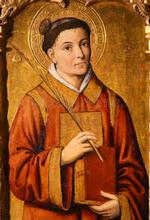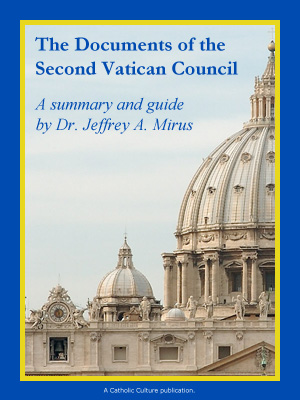St. José María Robles Hurtado
Almost 80 years ago, on a hill outside of the small town of Quila, Jalisco, Mexico, there was a deafening and deadly silence. A special heart, a priestly heart united with Christ’s own, was stilled. Its special beat, a loving palpitation for the Eucharist, was now silent.
The silence became one with the predawn darkness in which a group of soldiers finished carrying out their orders — the execution of Father José María Robles Hurtado, a member of Council 1979. Thanks to the glimmer of a small candle, the lifeless body of Father José was just visible. His corpse, still swaying from the hangman’s noose, was being slowly let down from an oak tree and placed into a cold, shallow grave.
Oddly enough, the glimmer of light that guided the executioners on the pitch-black hill came from a candle offered to them by Father José himself. Just before his death, he felt compassion for the soldiers who were stumbling in the darkness of that early June morning of 1927. He happened to have a small devotional candle in his pocket and offered it to them. Upon arriving at the oak tree he forgave the soldiers for what they were about to do. He told the man who held the noose, a friend of his, "Don’t dirty your hands." He took the noose, kissed it and placed it around his own neck. A few moments later, he was dead.
To this squad of soldiers, this priest got what he deserved. He had committed the crime of being a dedicated Catholic priest who publicly exercised his ministry in ways prohibited by the Mexican Constitution. He had accumulated numerous violations, and the soldiers witnessed one more when he was arrested.
At that moment, Father José was about to celebrate Mass unlawfully at the home of the Agraz family, which was trying to hide him. So members of the unremorseful death squad, believing they were justified in this killing, quickly threw dirt over his lifeless body. They then sent word to the town of what they had done, and proceeded to disperse. Father José was killed for being, from the government’s perspective, too Catholic.
A Heroic Priest
The heroic priest lived an intensely Catholic life in an anti-Catholic world. He was ordained in 1913 at the age of 25 in Guadalajara, and founded a religious community only two years later. This community, first named the Institute of Sisters Victims of the Eucharistic Heart of Jesus, is known today as the Sisters of the Sacred Heart of Jesus.
An avid writer, Father José wrote, published and distributed numerous Catholic newsletters, pamphlets and letters, and publicly taught the faith in ways contrary to the law of the land.
While serving as pastor of a parish in the city of Tecolotlán, a few years prior to his arrest, Father José began to promote public devotion to the Sacred Heart of Jesus. He did this through the power of his preaching, his example and strong devotion to the Eucharist. So intense was his commitment, he was known as the "Madman of the Sacred Heart."
He was known also for his devotion to the Virgin of Guadalupe, and promoted deep love for her throughout the region.
Love of his people led him to care for the sick in his parish with great diligence, and he spent many hours in the confessional.
Christ, the King of Mexico
With one act in particular, however, Father José declared religious freedom in Mexico and the autonomy of the Church. In an affront to the Mexican Constitution of 1917, which outlawed public processions and other devotional practices, this holy priest organized a public ceremony to lay the cornerstone for a huge cross on a hill in the geographic center of Mexico. This cross would be a public symbol of how Mexico recognized Christ as its king.
In anticipation of the event, signs were placed throughout the country proclaiming Christ as the "King of Mexico" and declaring the nation’s love for the Sacred Heart of Jesus, much to the chagrin of the Mexican authorities.
In 1923, an estimated 40,000 Catholics made a pilgrimage to this site and participated in the groundbreaking ceremonies. Back then it was known as "La Loma" and today as the mountain of Christ the King. This national act of faith promoted by Father José provoked those in power. The decision was made by the government to intensify the persecution of the Catholic Church and to "silence" this priest.
Persecution of Catholics throughout Mexico, known as the Cristeros era, lasted roughly from 1917 to 1937. The name Cristeros, derived from the Spanish Cristo Rey, Christ the King, refers to anti-government rebel fighters, including hundreds of Knights of Columbus.
"¡Viva Cristo Rey!" ("Long live Christ the King"), and "¡Viva Cristo Rey y Santa María de Guadalupe!" ("Long live Christ the King and Holy Mary of Guadalupe") were the last words of many Cristeros, Catholics and martyred priests and Knights. Emulating Christ on the cross, they would open their arms wide and yell out these words with their last breath. Photographs of these martyrs were cherished as holy cards; some were reprinted in Columbia magazine during the Order's extensive campaign of education about the persecution of the Church. To the government of Mexico these declarations of faith were clearly rebellious and treasonous. Yet the holy words were ratified by Pope Pius XI, who officially established the feast of Christ the King in 1925.
Help from the Vatican
In spite of intense persecutions and invitations to leave the country, Father José stayed in Mexico. He continued to minister to his suffering flock and offer consolation to the survivors and families of those who had been persecuted and killed by the government. Upon witnessing the slaughter of many Catholics, he went so far as to promote the armed defense of Catholics who were being persecuted. The promotion of the basic right of self-defense was seen by government officials as another violation of the anti-Catholic constitution.
Pope Pius XI complained about the 1917 constitution in his 1926 encyclical, Iniquis Afflictisque, written in regard to the persecution of the Church in Mexico. Citing offensive sections of the constitution, the pope wrote:
"Priests…must be not only Mexicans by birth and cannot exceed a certain number specified by law, but are at the same time deprived of all civil and political rights. They are thus placed in the same class with criminals and the insane… The vows of religious, religious orders, and religious congregations are outlawed in Mexico. Public divine worship is forbidden unless it takes place within the confines of a church and is carried on under the watchful eye of the Government. All church buildings have been declared the property of the state."
In spite of the complaints from Rome, many misguided minds saw the hanging of Father José, and the murders of so many others, as promoting the sovereignty of Mexico. In another section the pope honors those who died for their faith: "The clergy, on their side, have not hesitated to go to prison when ordered, and even to face death itself with serenity and courage."
The Ultimate Witness
Always giving priority to Christ in his life, Father José wrote poetry in expectation of his martyrdom. A portion reads:
"I want to love your Heart / my Jesus with delirium; / I want to love you with passion, / I want to love you until Martyrdom… / With my soul I bless you my sacred Heart. / Tell me: is the instant of my eternal union near? / Stretch out your arms, O Jesus, / Because I am your ‘little one’."
Truly, Father José is an example of the heroic virtues of many Mexicans who gave the ultimate witness. He was canonized by Pope John Paul II on May 21, 2000, with five other Mexican priest-martyrs who also were Knights. His feast day is celebrated on June 26, the day of his martyrdom. His legacy is carried on today by the community which he founded 75 years ago, the Sisters of the Sacred Heart of Jesus. The community has hundreds of sisters all over Mexico, and they are active also in Angola, Peru and the United States.
In the United States, the Sisters have two communities in California and four in South Carolina. In California, one is at St. Peter Church in Fallbrook, in the Diocese of San Diego, and the other at Our Lady of Perpetual Help Church in Los Nietos, in the Archdiocese of Los Angeles. In South Carolina, the Sisters serve at St. James in Conway, St. Philip’s in Lake City and St. Cyprian in Georgetown, all in the Diocese of Charleston. Wherever they serve, the Sisters faithfully live the charism of Father José. They are intensely eucharistic and devoted to Mary. They live in community and are dedicated to the service of the poor and those most in need.
May we all acquire a special heart, one united with Christ’s Sacred Heart, and may our hearts have a special beat, a heart pounding with love for the Eucharist, just like that heart of St. José María Robles Hurtado.
Pedro A. Moreno is a graduate of the Pontifical Catholic University of Puerto Rico. He is the director of the Light of Christ Institute for Lay Ministry Formation in the Diocese of Fort Worth, Texas. A lay Dominican, Moreno is an award-winning writer and a contributing editor to the North Texas Catholic, official newspaper of the Diocese of Fort Worth.
© Knights of Columbus Used with permission
This item 6354 digitally provided courtesy of CatholicCulture.org






